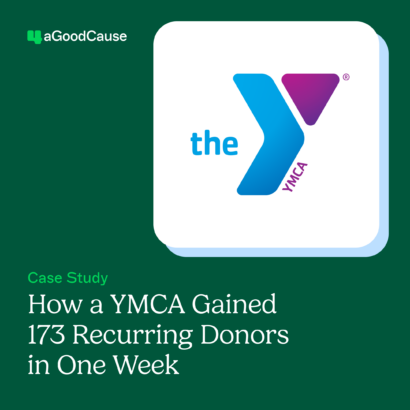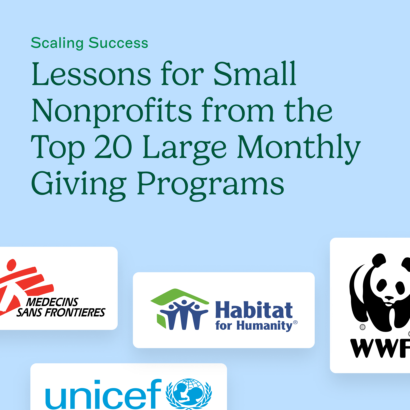Are you getting the most out of corporate matching gift programs?
A quick review of the mechanics and theory behind matching gift programs: Companies pledge to donate the same amount of money to the same nonprofits that their employees do — hence, matching their gift. They do so to uphold their corporate social responsibility, especially in the eyes of customers who want to make ethical decisions with their money.
It’s clear to see why these programs are so well-liked by nonprofits, too. Your donors get to double their support for your nonprofit without actually making another donation themselves. All they have to do is take a little time to fill out the appropriate forms on their employers’ online portal, and their employer takes care of the rest.
So if matching gift programs are such a win-win, why does anywhere from $6 to $10 billion in matching gift revenue go unclaimed every year?
Mostly, it comes down to awareness. Nonprofits can’t submit matching gift request paperwork on the behalf of their donors. Your donors have to know that these programs exist and how to submit their paperwork.
It’s up to your nonprofit to provide them with the necessary matching gifts information that will encourage them to participate in their employers’ programs!
In this post, we’ll share statistics about corporate matching gift programs and discuss how to use this information to improve your matching gift strategy:
- Percentage of Fortune 500 companies with matching gift programs.
- Common matching gift program restrictions and requirements.
- Impact of matching gift information on donation frequency and amount.
- Bonus! Corporate volunteer grant program statistics.
Ready to boost your nonprofit’s revenue from corporate matching gift programs? Read on!
1. Percentage of Fortune 500 companies with matching gift programs.
Corporations want to give to charities in order to show their employees and customers that they’re actively invested in bettering their communities. It’s a smart way to get positive press!
So it shouldn’t come as a surprise that many big companies offer matching gift programs. But do you know the actual percentage?
According to Double the Donation’s analysis, about 65% of Fortune 500 companies offer matching gift programs to their employees!
Such a high percentage has implications for your matching gift strategy — namely, that there’s a good chance you already count employees of these charitable companies in your donor database.
To take advantage of these existing connections to corporate philanthropy programs, you need to make sure your donors who work for these companies know about their employer’s program! Tailor your outreach by:
- Researching the top matching gift programs in a matching gift database or on Double the Donation’s website, where we’ve put together a list of more than 50 of the country’s most charitable companies. Do a search through your donor database for employees of these companies, then send them specific information about their employers’ program.
- Narrowing your search to top employers in your area, if you need a more focused strategy. For example, if you live in Atlanta, you might look for employees of Coca-Cola and other Atlanta-based companies that appear on lists of top philanthropic corporations. Send that top employer’s program requirements to employees in your database and encourage them to spread this information to their coworkers.
- Working backward by looking for the most common employers among your donors. You might find a significant percentage of your donors work for the same company, especially a local company, that doesn’t yet offer a corporate philanthropy program. Encourage donors employed by this company to petition their company to start a program. That’s how many corporate philanthropy programs start!
Don’t have your donors’ employment information on file? Don’t worry, there are still ways to make sure your donors can find the information they need.
Share a matching gift database search tool like Double the Donation with your donors, either via email, on your donation page, or on a dedicated matching gift page on your website. Using this search tool, donors can type in the name of their employer and instantly receive information about their matching gift program requirements and links to the necessary online forms.
2. Common matching gift program restrictions and requirements.
Not all corporate matching gift programs are the same. In fact, there’s a wide variety of program requirements and restrictions that your nonprofit needs to be aware of when building a matching gift strategy.
For one, not all companies match donations to all nonprofits. Commonly, companies will decline to match contributions to political or religious causes, or they might specifically offer to match contributions to causes they have a strong connection with.
Another common restriction has to do with employee status. Most companies match gifts made by full-time employees, and many will also match part-time employees’ donations. Not many companies match retired employees’ charitable contributions, though some do. Whether spouses’ contributions can be matched varies widely across programs.
We get into some interesting statistics when we consider the match ratio and maximum and minimum donation amounts that companies will match:
- 91% of companies match at a 1:1 ratio, contributing the same amount of money to the same nonprofit as the employee.
- 5% of companies match at higher rates of 3:1 or 3:1, while 4% of companies match at a lower rate of .5:1.
- 93% of companies will only match donations with a minimum amount of $50.
- 80% of companies will only match donations up to somewhere between $500 and $10,000.
- 40% more employees participate in matching gift programs when match maximums are set above $10,000.
These statistics can inform your matching gift strategy in a number of helpful ways. For instance, you likely already provide pre-set suggested donation amounts on your donation forms. If you know the majority of companies will only match gifts above $50, why not make that amount one of the lowest (if not the lowest) on your form?
You can also provide a note explaining that donors who are eligible to participate in corporate philanthropy programs should check their employers’ program requirements before making a donation.
Providing a matching gift database search tool directly on your donation form allows your donors to check their employers’ program details without leaving your donation form and potentially abandoning it.
Don’t limit yourself to just those examples! Get creative and let these statistics guide you.
3. Impact of matching gift information on donation frequency and amount.
Your hope as a nonprofit is that your donors would take any opportunity to support your mission when presented with it. Turns out, the data supports that hope!
Check out these significant statistics about the impact of matching gift information on donations:
- 84% of donors are more likely to make a donation if their gifts are eligible to be matched by their employer.
- 71% more donors respond to a fundraising appeal that mentions matching.
- Donation amounts increase an average of 51% when the fundraising appeal mentions matching.
Note that these last two statistics aren’t even impacted by your donor’s eligibility to have their donations matched! Simply mentioning matching gifts can vastly increase both the number and average value of donations.
These statistics have major implications for your marketing strategy. Consider: if all it takes to encourage higher and more frequent donations is awareness, you should do all you can to get the appropriate information in front of your donors whenever you can.
Here are some of the most effective places to promote information about matching gifts, whether as a paragraph of text, a picture, a matching gift database search tool plugin, or other format:
- Donation pages
- Confirmation screens
- Acknowledgment emails
- Matching gift page on your website
- Ways to Give page on your website
- Your website’s navigation
- Social media
- Direct mail
In each of these places, you should take care to make matching gifts seem as important and as easy as possible. Remember that you’re asking your donors to take an additional step after they’ve already made a donation. Assure them that the online matching gift request submission process only takes about 5 minutes and that the time is worth it.
4. Bonus! Corporate volunteer grant program statistics.
While matching gift programs are the most popular corporate philanthropy programs (and, often, the easiest to administer and participate in), they aren’t the only type of program out there. A close second is volunteer grant programs.
Volunteer grants reward employee volunteer time with monetary donations. These programs are typically structured in tiers instead of on an hour-to-dollar model. That means, for example, that an employee has to volunteer for 20 hours to earn a $500 donation to the nonprofit they volunteer with.
Here are a few relevant figures about volunteer grants:
- Volunteer grants are the second-most popular form of corporate philanthropy program, with 40% of Fortune 500 companies offering volunteer grant programs.
- Team volunteering is particularly popular, especially in recent years, accounting for about 70% of volunteer grant programs.
Start your corporate philanthropy program focus with matching gifts, since there is statistically a greater chance you have donors working for companies that offer these programs. Besides, monetary donations are a more common and quicker source of revenue for nonprofits than volunteering.
But if your nonprofit boasts a strong volunteer program, it might be worth your while to look through your volunteer database for employees of some of the biggest corporate volunteer granters.
With these key figures on your side, you’re now ready to tackle your corporate philanthropy strategy with renewed vigor!



